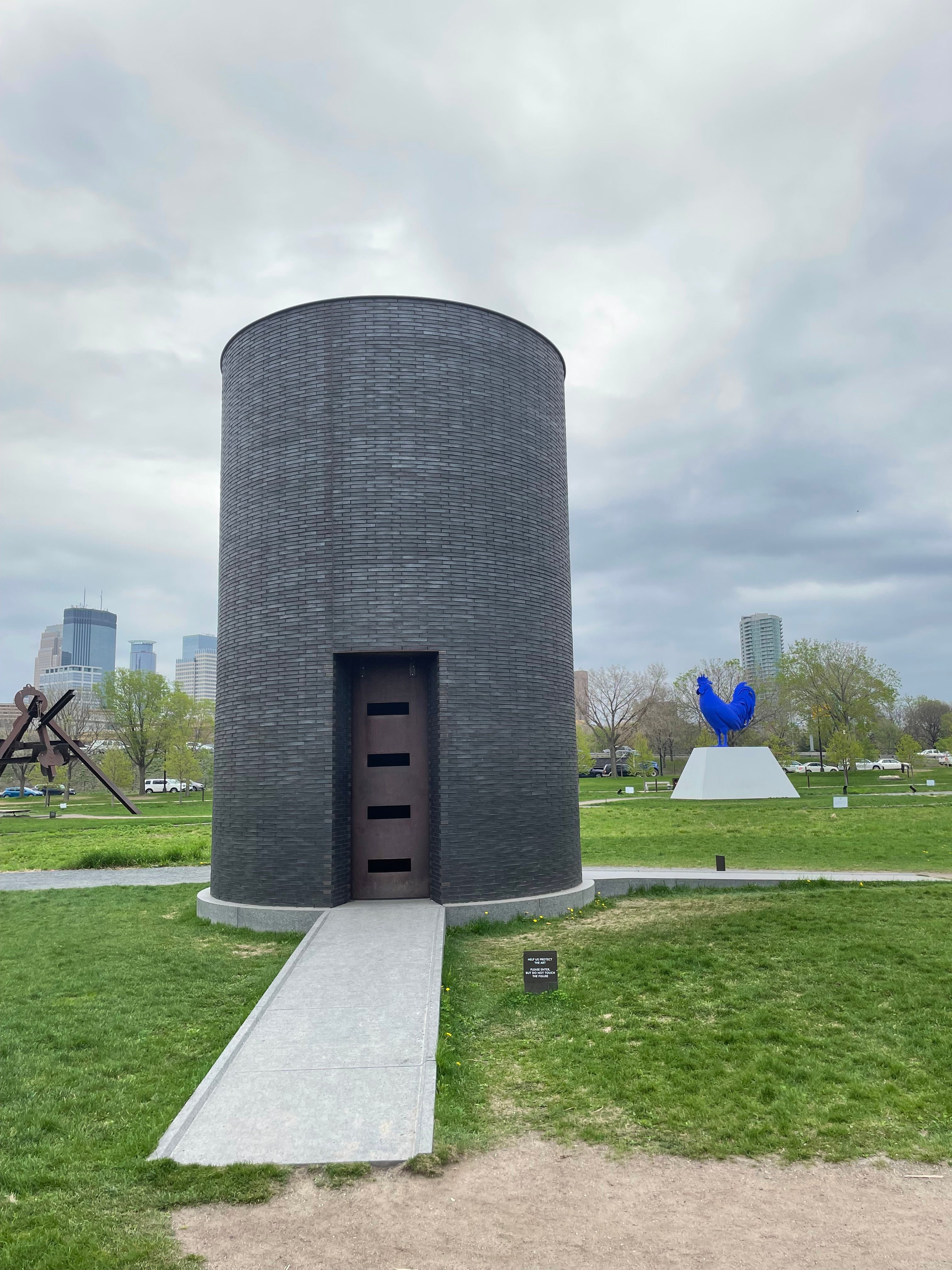
Black Vessel for a Saint sits on the southwest end of the Minneapolis Sculpture Garden with an air of incongruous monumentality. A 20-foot-tall cylinder of coal-black bricks, the Vessel rests on a raised cement platform, with two long cement ramps leading to a pair of doorways. Inside the cylinder, one encounters a six-foot tall, roofing tar-blackened statue of Saint Lawrence, who holds a luxuriant quill pen in his right hand and a Bible in his left. According to the didactics accompanying the Vessel, Theaster Gates—a polymathic Chicago artist known for his urban revitalization efforts and use of reclaimed materials—intended the temple-like structure to serve as “a secular sacred sanctuary—a place open to all for gathering and reflection.”
In contrast to this stated purpose, however, entry into this sculpture is currently obstructed by a plate steel door installed securely inside each doorway. The reason for the doors is perhaps evident: at some point, Lawrence’s pen and two forefingers seem to have suffered a blow that chipped them clean off, exposing what looked like white plaster underneath the tarred surface.
 While the need to protect the statue of St. Lawrence is understandable, this addition also seems to have a significant impact on how one experiences the piece as a whole. After all, don’t the locked doors represent an enormous alteration to the artwork’s original concept and stated purpose of creating interior space? In an attempt to answer this question, I decided to talk to other viewers about how they were experiencing Black Vessel for a Saint in its present form, and what new meanings they were making out of a closed vessel.
While the need to protect the statue of St. Lawrence is understandable, this addition also seems to have a significant impact on how one experiences the piece as a whole. After all, don’t the locked doors represent an enormous alteration to the artwork’s original concept and stated purpose of creating interior space? In an attempt to answer this question, I decided to talk to other viewers about how they were experiencing Black Vessel for a Saint in its present form, and what new meanings they were making out of a closed vessel.
Reactions to the Altered Art Installation
Not surprisingly, the presence of the locked doors impacted many peoples’ experiences of Black Vessel for a Saint. I began most of my conversations with viewers by introducing myself and asking, basically, “What did you think about this piece?”
One viewer seemed to think this was a silly question, and responded matter-of-factly, “Well, it was locked, so we didn’t spend much time looking at it.”
Most people simply expressed frustration about the way the doors limited their experience of the sculpture, like the person whose first response was, “Well, we thought it was going to be open.”
One viewer interpreted the discrepancy between the locked doors and the welcoming didactic materials as part of the piece itself: “The sign says ‘please enter,’ and then you can’t go in, so that made me wonder if it was like”—here, the viewer scrunched up their face, mimicking the expression of an impish artist thumbing his nose at a gullible audience— “like, I guess that’s part of it? ”
While not dissimilar in logic to other interpretations of the Vessel that took the doors as given, this response was particularly interesting because the materials provided by the museum—which the viewer had, understandably, taken at face value—led the viewer to assume that some intentional trickery was afoot.
The presence of the locked doors was not a total barrier to most viewers’ interaction with the Vessel, however, and in fact my own perception of the piece was greatly expanded by viewers who did not share my fixation with the doors. Several viewers’ responses revolved around the tactility of the brick structure, and it was interesting that the Vessel seemed to solicit a consciously embodied experience for many of the people with whom I talked.
One person told me, “I wanted to touch it. I don’t usually do that, but I wanted to touch it.”
Another viewer began their critical appraisal of the piece by saying, “It doesn’t feel good to me. It feels cold.” Interestingly, I spoke to the former viewer on a sunny spring afternoon, and to the latter on a day that was cool and gloomy.
Viewers’ tactile responses to the Vessel might simply reflect their common-sense understanding that brick is pleasant to touch under certain conditions, and not others. Additionally, viewers might feel implicitly invited to touch the structure by the (currently misleading) signage provided by the Walker, which reads, “Please enter, but do not touch the figure.” Not having been specifically prohibited from touching the structure that surrounds the figure, viewers may feel empowered to physically engage with the brick cylinder as they would any other building.
One person may have landed on this distinctive aspect of Black Vessel for a Saint when they wondered aloud, “In a way it seemed more interactive than a lot of the pieces here, if that makes sense?” Even as the doorways are barred, preventing entry into the sanctuary, it seems possible that many viewers still respond to this structure as something that was made for them, because a “building” in its most basic definition is a structure made for people.
To push further on this viewer’s insightful response, I wonder how many visitors to the Sculpture Garden are unsure if the other postmodern works on display are really “for them.” Perhaps it is fair to say that many of the other sculptures are not as interactive as Gates’ piece because the habitable form of the Vessel makes it more psychologically accessible, even if its doors are closed.
Reflecting on Gates’ Purpose
In thinking about this aspect of the sculpture, it seems important here to recall Gates’ long standing practice as a potter. In a 2017 conversation with Walker curator Victoria Sung, Gates outlined some of the ways in which Black Vessel for a Saint—which he referred to as “a large pot made out of clay”— connects to the themes present in the rest of his oeuvre:
You’re never thinking about the pot independent of those who might gather with the pot.… What I’m after is creating opportunity after opportunity for more people to gather. And if they gather in front of a tar painting, inside of a museum, that’s awesome. But I also love the idea that I could create a space where people would be able to have shelter, experience performances, and reflect together on the possibilities and the challenges of urban space. My investment in things is really about a deep investment in people.1
That Gates’ intentions for this piece are still being partially fulfilled by a Vessel with locked doors is a testament to the strength of the concepts in play.
However, because Gates’ primary intention seems to have been to create a space for people to gather, those locked doors forced many viewers to formulate an almost tragically contrasting interpretation. In general, many of these interpretations seemed to hinge on the feeling of alienation that arose when viewers peered into the Vessel at the figure of St. Lawrence through the apertures in the thick steel doors.
One viewer was almost indignant when they considered the meaning of the piece: “This is what religion does. It makes you feel curious but then it shuts you out. It’s like there’s something going on in there, but I am not invited to it.”
This viewer’s companion said simply, if somewhat metaphysically, “I feel like my third eye isn’t open.”
For another person, it felt like “looking in on a religion that I wasn’t necessarily a part of.”
But not all responses were negative. Last summer, I visited the sculpture and saw that coins and flowers had been thrown at the base of the statue, possibly indicating that at least one person was treating the sculpture as a shrine, and perhaps responding to some “sacred” power that St. Lawrence retained in his current “secular” home.
Finally, one of the viewers I spoke to made an open-ended appraisal of the piece as it currently stands: “I think it mostly just provokes curiosity.”
This is, perhaps, Black Vessel for a Saint’s greatest virtue, at least for now. While originally intended as a secular-sacred space for gathering and reflection, viewers now have to contend with what it means to be shut out of a sanctuary that they might have otherwise been invited to.
Most of them, from what I could tell, didn’t feel the loss too painfully, as if it felt appropriate that full access to the saint and his shrine was not really for them, perhaps in the same way that the Basilica of Saint Mary, looming to the northeast, might not really be for them.
Instead of creating a physical space, it seems possible that Black Vessel for a Saint currently functions mostly to provoke curiosity, opening up enough internal space within viewers so they are able to ask themselves, “if I could enter this sacred space, would I really want to?”
______
1. Victoria Sung, “Creating Space for the Possibility of a Sacred Moment: Theaster Gates on Black Vessel for a Saint,” August 27, 2019, walkerart.org/magazine/theaster-gates-discusses-black-vessel-for-a-saint



Your Comments :